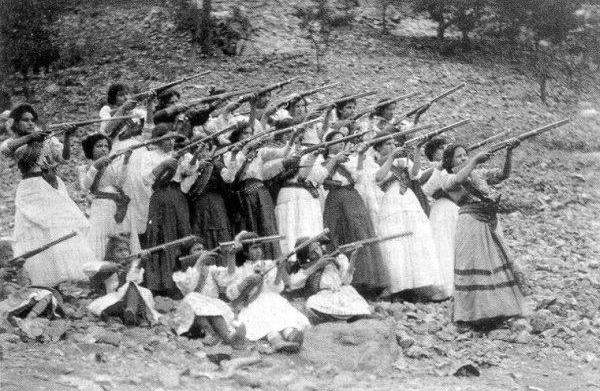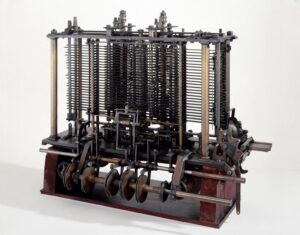Winner of the Spring 2018 StMU History Media Award for
Best Article in the Category of “Gender Studies”
“La Adelita” was one of the most popular corridos, or songs of romance, during the Mexican Revolution (1910-1920).1 This song is the love story of a young woman who travels with a sergeant and his regiment during the revolution.2 The song praises Adelita, the sweetheart of the troop, for both her beauty and her valor, noting how she is wanted by the other soldiers. We can imagine this woman as an object of desire, whose beauty and physique attracted the soldiers, and eventually broke their hearts. But this description is actually… incorrect.3
The Adelita, also known as soldadera, or female soldier, is the term used to describe women who contributed to many aspects of the Mexican Revolution. These women worked as nurses, food providers, lovers, spies, messengers, and fighters.4 In fact, some reached the rank of colonel and general. Many of them were forced by their husbands to follow them and work in the camps, but there were also those who volunteered to join the cause.5 Today, soldaderas are remembered as strong and courageous women who took up weapons and became fighters, often having to cut their hair and dress to appear like their male counterparts, because of the oppressive gender inequality prevalent in the Mexican society of that time.6 There is one soldadera in particular, Petra Herrera, also known as La Guerrera, and as La Generala (female general), who joined the cause and fought with the strongest of the soldiers. But what inspired women to join their male counterparts to fight this war, and why did the revolution even happen?

To answer this question and to be able to understand why these women now make up a very important aspect of Mexico’s history and its formation as a country, we need to go back in time to 1876, when the general and politician Porfirio Díaz became president. Porfirio Díaz was known to be a corrupt, elitist president, who favored wealthy landowners, industrialists, and foreign interests.7 The country was also known for the slave-like conditions rural people faced while working on the haciendas owned by wealthy landowners.8 These rural workers were very dissatisfied with the lack of voice they had in the government. But the precipitating event that sparked the revolution was Díaz’s announcement, in 1908, that he would run for his seventh term as president in 1910. This caused controversy among the people who had been suffering from his long regime. Francisco I. Madero then rose as the leader of the Antireeleccionistas (Anti-Reelection alliance). Madero subsequently announced that he would be running for president against Díaz. This prompted the mobilization of armies throughout Mexico. Countless leaders, such as Pascual Orozco and Pancho Villa, began raiding government garrisons as part of an uprising to remove the current president and eventually, elect a new president for the country.9 These were some of the events that inspired and sparked the courage of not only men but of women as well, to join the armies and fight for the shared goal of overthrowing Díaz’ dictatorship and make democracy in Mexico a reality.10

Petra Herrera witnessed the suffering of her country and decided to take action. She witnessed the harshness of landowners and the terrible conditions in which workers lived. She knew that the government had to change from being a corrupt one to being a democratic and fair one. But how would she help? Women at that time faced strict social prohibitions that kept them from playing important roles in the workforce. Instead, they were expected to be caregivers, stay at home, and take care of their children. Women were seen as precious and delicate, something that could not blend with the harshness of war. Petra, instead of following that norm, disguised herself as a man and started calling herself “Pedro Herrera” in order to join the revolutionary troops of Pancho Villa.11
During her time in the camp, she had to lie to her fellow soldiers in order to protect her identity. For example, she would lie that she shaved at dawn before the other soldiers woke up.12 Because of this, “Pedro” was able to blend in perfectly. Quickly after her joining the army, Petra was recognized as an aggressive fighter who carried out military operations efficiently and strategically. In disguise, she came to be known as a courageous and brave soldier, and was soon praised for her intelligence and her skills at blowing up bridges.

Thanks to the acknowledgment she faced on behalf of her peers and her establishment as a strong soldier, Petra decided she would confess her true identity. She believed this would not affect her position or status in the militia, and that she would be accepted and even promoted to general. But sadly, when she told the truth, she was removed from the army instead.13 Consequently, she decided to organize a group of women who were likewise removed from combat, even after they had fought courageously for the same cause as their male counterparts. Petra decided not to give up, and she organized a group of more than four hundred women with the same motive: to put an end to the current presidency and the hardships that Díaz had imposed on the citizens. Her militia not only fought in several battles, but Petra united these fighting women with Pancho Villas’ forces, despite his denial of them fighting and bearing arms. Together, they were able to take the city of Torreón on May 30, 1914, which had been a military base for Díaz’s central federation.14 At the end of the fight, she requested General Castro, a leader of the revolution, to allow her to re-enter the military and make her general, but he only granted her the title of colonel and disbanded her woman’s brigade.15 But her work did not end there. After the demobilization of the woman’s militia, Petra decided to join Venustiano Carranza, one of the main political leaders of the revolution who later became president of Mexico. She became a spy for him and worked as a bartender in Jimenez, a city in the northern part of Mexico.16 But while she was working there, she was shot three times by a group of drunk men, later dying from the injuries.
Despite the effort and the work Petra Herrera gave for the revolution, she has barely received any acknowledgment as a soldadera. There are several causes for this. Men during those times had mixed feelings about women being in combat and the role they had in the fight.17 One of the most passionate opponents of women joining the militia and bearing arms was Pancho Villa. He viewed women as liabilities to an army’s offensive strategy and combative potential, even though Petra Herrera and other great female combatants fought at his side several times to free the country from the oppressive presidency.18 There was also the idea that soldaderas were just images of romance during the Mexican Revolution, such as the song of “The Adelita,” contributing to recognizing only a few of them as strong fighters and contributions to this era.19 These women should be acknowledged and we should grant them a higher praise because many were forced to take this role of soldaderas after being abducted and often raped by revolutionaries who invaded their towns and cities. At the end of the day, the labor and effort of women such as Petra were very important factors for what we have come to know as the Mexican Revolution.
Hear the ballad of La Adelita
La Adelita
Spanish20
Little Adela
English translation21
- Beatriz de León, “La Adelita: El Rostro de La Soldadera,” in Reforma (Mexico D.F., Mexico), 2010. ↵
- Beatriz de León, “La Adelita: El Rostro de La Soldadera,” Reforma (Mexico D.F., Mexico), 2010. ↵
- Andrés Reséndez Fuentes, “Battleground Women: Soldaderas and Female Soldiers in the Mexican Revolution,” The Americas, no. 4, (1995): 55-57. ↵
- Oxford Research Encyclopedias, May 9, 2016, s.v. “Working Women in the Mexican Revolution,” by Susie S. Porter. ↵
- Donna Seaman, “Las Soldaderas: Women of the Mexican Revolution,” Booklist 103, no. 12, (2007): 18. ↵
- Elizabeth Salas, Soldaderas in the Mexican Military: Myth and History (Austin, Tex.: University of Texas Press, 1990), 48-49. ↵
- Encyclopedia Britannica, October 25, 2017, s.v. “Mexico | History, Geography, Facts, & Points of Interest – The Mexican Revolution and Its Aftermath.” ↵
- Encyclopedia Britannica, January 2, 2018, s.v. “Mexican Revolution | Causes, Summary, & Facts.” ↵
- Encyclopedia Britannica, January 2, 2018, s.v. “Mexican Revolution | Causes, Summary, & Facts.” ↵
- Encyclopedia of Latin American History and Culture, January 2008 v.s. “Women,” by Francesca Miller and Meredith Glueck. ↵
- Delia Fernandez, “‘La Adelita’ Becomes an Archetype of the Mexican Revolution,” McNair Scholar Journal, Vol. 13, (2009): 57-58. ↵
- Jason Porath, Rejected Princesses: Tales of History’s Boldest Heroines, Hellions, and Heretics, (New York, NY.: Patreon, 2016), 123-124. ↵
- Elena Poniatowska, Las soldaderas: women of the Mexican revolution (El Paso: Cinco Punto Press, 2006), 45. ↵
- Encyclopedia Britannica, October 25, 2017, s.v. “Mexico | History, Geography, Facts, & Points of Interest – The Mexican Revolution and Its Aftermath.” ↵
- Jason Porath, Rejected Princesses: Tales of History’s Boldest Heroines, Hellions, and Heretics, (New York, NY.: Patreon, 2016), 123-124. ↵
- Jason Porath, Rejected Princesses: Tales of History’s Boldest Heroines, Hellions, and Heretics, (New York, NY.: Patreon, 2016), 123-124. ↵
- Wilma Mankiller, Marysa Navarro, and Gloria Steinem, “Feminism and Feminisms: Feminism,” in Reader’s Companion to U.S. Women’s History (Boston, 1998), 187. ↵
- Oxford Research Encyclopedias, May 9, 2016, s.v. “Working Women in the Mexican Revolution,” by Susie S. Porter. ↵
- Alicia Arrizón, “Soldaderas and the Staging of the Mexican Revolution,” TDR: The Drama Review 42, no. 1, (1998): 105–107. ↵
- Amparo Ochoa, “La Adelita,” Corridos Y Canciones de la Revolucion Mexicana, Ediciones Pentagrama, 1995. Featured in video “La Adelita – Amparo Ochoa,” Courtesy of Youtube (https://www.youtube.com/watch?time_continue=64&v=hlGtOv-QEQQ ). ↵
- “La Adelita,” Mexican Folk Song, translation of last three stanzas by phantasmagoria ↵




127 comments
Alejandro Fernandez
In this article, the author highlights Petra Herrera and her courageous efforts during the Mexican Revolution. In particular, it was interesting to learn about the different ways women contributed to the revolution as well as the discrimination they continued to receive. Ultimately, it’s important to recognize that historical figures like Petra Herrera are ones that paved the future not only for women, but individuals across the globe.
Sofia Perez
Hi Regina, fantastic article! I do not know much about Mexico’s history, so reading about their revolution was very informative. La Adelita has a very significant meaning in Mexico’s Revolution, as it conveys the rise of women. One of many impactful women at the time, Petra Herrera, took action as she helped fight for independence, which was not easy as she got shot three times.
Barbara Ortiz
What a great article and congratulations on the award. What a great subject to learn about her role during the Mexican revolution. Especially during Women’s history month, its good to see stories of women and how they made contributions through the ages. I also like to see the contributions of minority women showcased. Her bravery was tremendous and yet very interesting how she met her death.
Anna Steck
I found this article very interesting. I was unfamiliar with Petra Herrera and her story and I was fascinated by all the ways she stood firm in what she believed. What a powerful woman. It also shows very clearly how women were valued at the time as she had to conceal her identity in order to be respected when she was clearly very talented. What an interesting article.
Kristen Leary
This is a really cool article! I can’t say I knew anything of it until reading this article, so I’m glad I got to learn about these women from your wonderfully written article. Your writing style is very engaging, and from the very first paragraph you are able to hook the reader. I enjoyed reading about Petra, and I noticed the parallels to the story of Mulan, which I thought was cool. Great article and congratulations on the award.
Adelina Wueste
This was such an excellent article! It was very interesting to learn about a female soldier who hid her identity to fight for an important cause. I found it to be sad how despite Petra being such a strong fighter, she was stripped of all her recognition and praise once she revealed that she was a woman. Its inspiring to know that Petra was able to organize a group of women who had been in a similar situation to hers. It was unfortunate that although Petra and the other women made clear and successful efforts in the revolution, they were not recognized for their work and were looked down on because they were women. It was great to hear about Petras constant work and strong drive despite being doubted by the men round her.
Anayetzin Chavez Ochoa
Finally!!! I get to read about women being part of the “big guns” instead of just being mothers at home! I remember being informed that Mexican Presidents only serve once, but for six years, unlike the United States who serve twice for four years. Her removal from the army reminds me of when Mulan revealed herself (accidentally), as she was praised under her male counterpart’s alias, but then scorned. I’m glad to learn of my people’s history, especially from the side of the women as women today fight for their equality on the streets of Mexico and die for such a right. Beautiful article!
Christopher Morales
This article was written well. I even watched the youtube video you provided, and I feel like you covered it nicely. I cannot believe that even after her proven accomplishments they still removed her from the regime. This speaks a lot to the times and how women were treated. Her determination to start a militia of women to help fight and push the war efforts showed her courage and desire to help. She is a great example for everyone to not give up.
Marie Peterson
This was a great article and congratulations on the award. This was an interesting read on such an important part of the Mexican Revolution. Women stepped up to work toward progress even against the resistance of men they were trying to help. It’s sad to read stories about how even in the face of an enemy women were seen as less than to fight for what was right. Good job!
Jared Sherer
Ms. De La Parra takes an obscure topic (admittedly based on the misogyny of the time) and makes it come alive for the reader. The time of the Mexican Revolution, especially in Mexico, was a time of very rigid gender and family roles. Men were fighters and women were caretakers and family-oriented. Women were not soldiers and were not put in danger in combat. Generala Herrera broke that mold, several times, despite even her revolutionary brethren (including even Pacho Villa) being adamantly against her, as a woman, being among their soldier ranks. Ms. De La Parra makes it clear this was a lifelong struggle, with Herrera being drummed out of the fighting force and made to create her own women’s brigade. It is important to seek out these stories of women and others who have largely been ignored by the history books and historians, and highlight their unique stories for future generations who would otherwise not know of their heroics and downright grit. This is not “revisionist” history, but is in fact expanding the story of prior generations to tell the full (sometimes not politically correct) story of our forebears. Well done, Ms. De La Parra, on bringing the story of Petra Herrara, soldadera, to light for this and future generations.